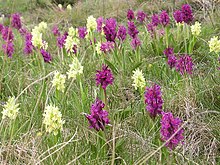Dactylorhiza sambucina
| Dactylorhiza sambucina | |
|---|---|
 |
|
| Scientific classification | |
| Kingdom: | Plantae |
| (unranked): | Angiosperms |
| (unranked): | Monocots |
| Order: | Asparagales |
| Family: | Orchidaceae |
| Subfamily: | Orchidoideae |
| Tribe: | Orchideae |
| Subtribe: | Orchidinae |
| Genus: | Dactylorhiza |
| Species: | D. sambucina |
| Binomial name | |
|
Dactylorhiza sambucina (L.) Soó (1962) |
|
| Synonyms | |
|
|
The Elder-flowered Orchid (Dactylorhiza sambucina) is an herbaceous plant belonging to the family Orchidaceae. It is quite common and widespread throughout much of Europe from Portugal east to Finland and Ukraine. The flowers appear in spring and summer, in various colors from yellow to purple.
The name of the genus Dactylorhiza is formed from Greek words δάκτυλος "daktylos" meaning "finger" and ρίζα "rhiza" meaning "root" and refers to the tubers of this plant, that are split into several tubercles. The specific Latin name "sambucina", refers to the smell of Elder (Sambucus nigra) emanating by some plants of this species.
The scientific binomial name of this plant was initially Orchis sambucina, proposed by the Swedish naturalist and botanist Carl Linnaeus in 1755. The name was subsequently amended to the one currently accepted (Dactylorhiza sambucina), by the Hungarian botanist Károly Rezső Soó in 1962.
Dactylorhiza sambucina reaches on average 10–40 centimetres (3.9–15.7 in) inheight. These plants are bulbous geophytes with underground tubers or bulbs that annually produce new stems, leaves and flowers.
The leaves are and vary from 4 to 7 per plant. The lower leaves are oblong-obovate with obtuse apex, while the upper leaves are lanceolate with acute apex. Size of leaves: width 1 to 2.5 cm, length 6 – 12 cm.
The underground part of the stem has two tubers each one more or less deeply divided into several lobes (a characteristic of the genus Dactylorhiza), the first one plays the important functions of supplying the stem, while the secondary ones collect nutrient materials for the development of the plant that will form in the coming year.
The inflorescence is 5–10 centimetres (2.0–3.9 in) long and it is composed of flowers gathered in a dense spike. The flowers grow in the axils of bracts that ae membranous and lanceolate-shaped. The flowers appear from mid-April to early July. Their colors vary from yellow with light reddish stains or purple speckled with darker spots on the labellum.
They are hermaphrodite and pollinated by insects (entomophily), especially bumblebees (Bombus species). These orchids are almost without nectar, but they are visited by various pollinator insects as they are confused with other plants with nectar. The seed germination is conditioned by the presence of specific fungi.
...
Wikipedia
